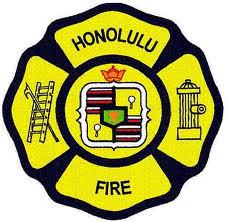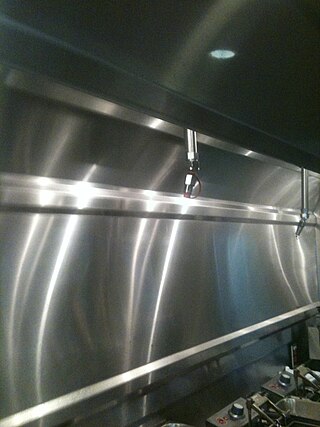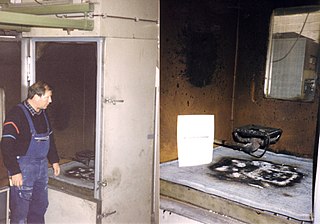
A fire sprinkler system is an active fire protection method, consisting of a water supply system providing adequate pressure and flowrate to a water distribution piping system, to which fire sprinklers are connected. Although initially used only in factories and large commercial buildings, systems for homes and small buildings are now available at a cost-effective price.

The National Electrical Code (NEC), or NFPA 70, is a regionally adoptable standard for the safe installation of electrical wiring and equipment in the United States. It is part of the National Fire Code series published by the National Fire Protection Association (NFPA), a private trade association. Despite the use of the term "national", it is not a Federal law. It is typically adopted by states and municipalities in an effort to standardize their enforcement of safe electrical practices. In some cases, the NEC is amended, altered and may even be rejected in lieu of regional regulations as voted on by local governing bodies.

The Honolulu Fire Department (HFD) provides fire protection and first responder emergency medical services to the City & County of Honolulu, Hawaii, United States, under the jurisdiction of the Mayor of Honolulu. Founded on December 27, 1850, by Kamehameha III and Alexander Cartwright, the Honolulu Fire Department serves and protects the entire island of O'ahu, covering over 600 square miles (1,600 km2) of territory, home to more than 880,000 residents and over 4 million annual visitors.

Fire safety is the set of practices intended to reduce destruction caused by fire. Fire safety measures include those that are intended to prevent the ignition of an uncontrolled fire and those that are used to limit the spread and impact of a fire.
The publication Life Safety Code, known as NFPA 101, is a consensus standard widely adopted in the United States. It is administered, trademarked, copyrighted, and published by the National Fire Protection Association and, like many NFPA documents, is systematically revised on a three-year cycle.

A fire sprinkler or sprinkler head is the component of a fire sprinkler system that discharges water when the effects of a fire have been detected, such as when a predetermined temperature has been exceeded. Fire sprinklers are extensively used worldwide, with over 40 million sprinkler heads fitted each year. In buildings protected by properly designed and maintained fire sprinklers, over 99% of fires were controlled by fire sprinklers alone.
The International Building Code (IBC) is a model building code developed by the International Code Council (ICC). It has been adopted for use as a base code standard by most jurisdictions in the United States. The IBC addresses both health and safety concerns for buildings based upon prescriptive and performance related requirements. The IBC is fully compatible with all other published ICC codes. The code provisions are intended to protect public health and safety while avoiding both unnecessary costs and preferential treatment of specific materials or methods of construction. The code is updated every three years.
Fire prevention is a function of many fire departments. The goal of fire prevention is to educate the public on the precautions which should be taken to prevent potentially harmful fires and how to survive these fires if they do occur. It is a proactive method of preventing fire-based emergencies and reducing the damage caused by them. Many fire departments have one or more Fire Prevention Officers, which may also be a routine duty of firefighters.

A fire pump usually refers to a pressure-increasing component of the water supply for fixed-place fire suppression systems such as fire sprinklers, standpipes, and foam systems. Fire pumps are also a critical component integrated into fire trucks and fire boats, and serve a similar purpose boosting water supplies for firefighting hose operations.

Fire protection is the study and practice of mitigating the unwanted effects of potentially destructive fires. It involves the study of the behaviour, compartmentalisation, suppression and investigation of fire and its related emergencies, as well as the research and development, production, testing and application of mitigating systems. In structures, be they land-based, offshore or even ships, the owners and operators are responsible to maintain their facilities in accordance with a design-basis that is rooted in laws, including the local building code and fire code, which are enforced by the authority having jurisdiction.

Fire suppression systems are used to extinguish, control, or in some cases, entirely prevent fires from spreading or occurring. Fire suppression systems have an incredibly large variety of applications, and as such, there are many different types of suppression systems for different applications being used today. Of these, there are some that are still in use but are no longer legal to manufacture and produce.
Active fire protection (AFP) is an integral part of fire protection. AFP is characterized by items and/or systems, which require a certain amount of motion and response in order to work, contrary to passive fire protection.

A fire alarm system warns people when smoke, fire, carbon monoxide, or other fire-related or general notification emergencies are detected. These alarms may be activated automatically from smoke detectors and heat detectors or may also be activated via manual fire alarm activation devices such as manual call points or pull stations.
Heat and smoke vents are installed in buildings as an active fire protection measure. They are openings in the roof which are intended to vent the heat and smoke developed by a fire inside the building by the action of buoyancy, such that they are known as "gravity vents".

A flammable material is something that can burn in air under certain conditions. A flammable material is flammable if it ignites easily at ambient temperatures. In other words, a combustible material ignites with some effort and a flammable material catches fire immediately on exposure to flame.
American Society of Safety Professionals (ASSP), formerly known as American Society of Safety Engineers (ASSE) until June 2018, is a global organization of more than 37,000 occupational safety and health (OSH) professional members who manage, supervise, research and consult on work-related OSH concerns in all industries, government and education. The Society's members use risk-based approaches to prevent workplace fatalities, injuries and illnesses.

Sprinkler fitting is an occupation consisting of the installing, testing, inspecting, and certifying of automatic fire suppression systems in all types of structures. Sprinkler systems installed by sprinkler fitters can include the underground supply as well as integrated overhead piping systems and standpipes. The fire suppression piping may contain water, air, antifreeze, gas or chemicals as in a hood system, or a mixture producing fire retardant foam.
Water transportation and distribution networks require hydraulic calculations to determination the flowrate and pressure characteristics at one or several consumption points and the water supply flowrate and pressures needed to meet the design requirements.
The Fire Sprinkler Incentive Act (FSIA) is the name of a piece of legislation that has been introduced in both the House and the Senate since 2003. The legislation would amend the 1986 Internal Revenue Code by classifying fire sprinkler retrofits as either a Section 179 depreciation deduction or a fifteen-year property for purposes of depreciation. Currently the tax depreciation time for commercial property is 39 years and 27.5 for residential.
The Home Fire Sprinkler Coalition (HFSC) was founded in 1996. It is a nonprofit organization working in the United States and Canada. HFSC's web site details its mission statement and board members. For several years, the United States Fire Administration has had a partnership with HFSC. Since 1997, HFSC has worked with Ron Hazelton as its spokesperson. HFSC has earned several federal Fire Prevention & Safety Grants, primarily to develop free educational materials for use by fire departments. In 2010, HFSC collaborated with FM Global to study the environmental impact of home fires.











